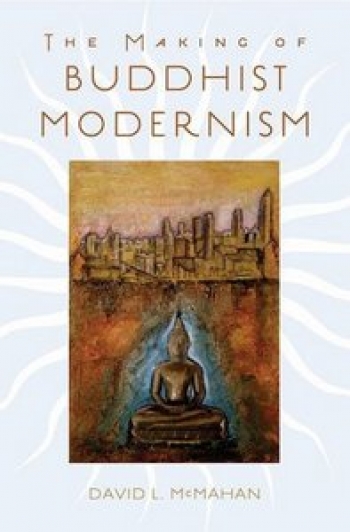David L. McMahan, 2008, Oxford University Press
David L. McMahan’s book The Making of Buddhist Modernism is a study of the new modes of discourse and practice within Buddhism for the past 150 years, and its intellectual culture since the onset of modernity and a global community. This sympathetic yet critical work will be valuable to any Buddhist of the 21st century and anyone who wants to know why Buddhism is commonly seen as harmonious with science, more “rational” than other religious cultures, places less emphasis on a faith commitment, and is the “ancient” complement to psychology and neuroscience.
This book’s contention is that Europeans, Americans, and Asians since the mid-1800’s (with varying loyalties and agendas) constructed a unique modernist Buddhism. This “co-creation” was achieved through ideological and imaginative encounters between science, mythology, literature, art, psychology, and Western political and cultural ideals. The analysis and evidence that McMahan provides is eloquent, convincing and engaging. It will be intellectually challenging for any practicing Buddhist, but the insight that McMahan offers is more than worthwhile.
The American school of Buddhist Studies is a young tradition (compared to its Japanese, Anglo-German, Franco-Belgian, and Leningrad counterparts). But it has proven to be no less rigorous thanks to the philosophical sophistication of its proponents. McMahan’s ideas are shaped by his experience within this American school and his mastery of other discourses that shaped Western consciousness. With this background, he attempts to “account for some of the ways in which Buddhism has been infused into the world constituted by both the tacit understandings and social practices, on one hand, and explicit theories on the other, that constitute modernity” (p. 15). McMahan looks at rationalism, theosophy, perennialism (the idea that all religions lead to one Truth), Romanticism (this school of thought, which was driven by Western intellectuals disillusioned with industrialization and urbanization, is particularly important in McMahan’s analysis) and other ideas to frame ways Buddhist sympathizers and writers used to diffuse Buddhism in a modernist form. How was utilizing Western discourse seen as a “skilful means” to propagate the Dharma? How was mindfulness of the body re-interpreted as mindfulness of the ecology and nuclear war? Throughout his chapters, he demonstrates convincingly what was won (one of them being public acceptance of Buddhism as a “rationalist” religion) and what was lost. In my opinion, this book offers a true adventure for the Buddhist reader, as well as anyone interested in intellectual or cultural history.
McMahan also utilizes a wide range of thorough historical evidence (demonstrating that Western perceptions of Buddhism from the mid-1800’s onward were very complex, and Asian responses to the colonial, Christian challenge were equally varied), scientific studies of meditation and psychology, and “popular” literature coming from celebrated figures like Thich Nhat Hanh and Western Buddhist leaders who, while advocating modern ideas, stake a claim on the “original tradition” of the Buddha. He leaves no stone unturned, examining also modern Western Buddhists who advocate a more traditional framework of discipleship (such as Bhikkhu Bodhi). Every chapter in his book is filled with insightful and realistic observations about Buddhism’s decontextualization and recontextualization, including a wonderful section about “global folk Buddhism” (p. 261 – 5). This folk Buddhism inverts many ideas about “unsophisticated, local” folk religion by being global, dismissing ethnic differences, and being embedded in global and academic discourse, popular culture, and digitization (Buddhistdoor is a notable culprit in the last factor). Despite tackling a dense and difficult topic, McMahan’s work is extremely helpful for the modern Buddhist in understanding recent trends in Buddhism and what has been won – as well as what is at stake.
At the risk of repeating myself, The Making of Buddhist Modernism is undeniably challenging. It takes some of our most cherished assumptions about modern Buddhism and demonstrates that they are precisely the results of modern discourse and reframing. While by no means an inauthentic or illegitimate discourse of Buddhism, this is nevertheless one Buddhism of many: formed by the religion’s encounter with Western discourse and the juggernaut of modernity. This is the story that McMahan has traced and presented, in a vivid and illuminating way. Despite many questions that remain, the very survival of the sasana is evidence that the battle has been won to a great extent. But the future and beyond is still an open question, and the prosperity of Buddhism is now up to us.















